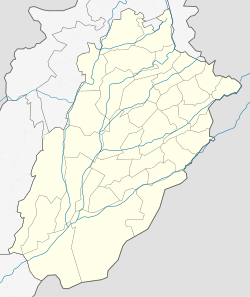Gurjanwala
|
Gujranwala گوجرانوالا |
||||||
|---|---|---|---|---|---|---|
| City District / Divisional Capital | ||||||
|
||||||
| Location in Punjab, Pakistan | ||||||
| Coordinates: 32°9′24″N 74°11′24″E / 32.15667°N 74.19000°ECoordinates: 32°9′24″N 74°11′24″E / 32.15667°N 74.19000°E | ||||||
| Country | Pakistan | |||||
| Region | Punjab | |||||
| District | Gujranwala District | |||||
| Autonomous towns | 7 | |||||
| Union councils | 19 | |||||
| Area | ||||||
| • Total | 3,198 km2 (1,235 sq mi) | |||||
| Population (2015) | ||||||
| • Total | 2,723,009 | |||||
| Time zone | PKT (UTC+5) | |||||
| Postal code | 52250 | |||||
| Area code(s) | 055 | |||||
Gujranwala (Punjabi and Urdu: گوجرانوالا) is an industrial city in Gujranwala District in the province of Punjab in Pakistan. Gujranwala is 226 metres (744 ft) above sea level and is the seventh-most-populous of the Pakistani metropolitan areas.
According to the Imperial Gazetteer of India, Gujranwala was founded by the Gurjars and renamed Khanpur by the Sherzai tribe of Iran who settled there; however, its old name has survived. Many historians also note that the place was named for the Gurjars who ruled the Gurjara-Pratihara.
In 630, the Chinese Buddhist pilgrim Xuanzang visited a town known as Tse-kia (or Taki), near present-day Gujranwala; a mound near the contemporary village of Asarur has been identified as the site of the ancient city. From the beginning of the 7th century Rajput kingdoms dominated Eastern portions of Pakistan and northern India.
In 997 CE, Sultan Mahmud Ghaznavi, took over the Ghaznavid dynasty empire established by his father, Sultan Sebuktegin, In 1005 he conquered the Shahis in Kabul in 1005, and followed it by the conquests of some western Punjab region. Eastern Regions of Punjab from Multan to the Rawalpindi in north (Including region of present-day Gujranwala) remained under Rajput rule until 1193.
...
Wikipedia






